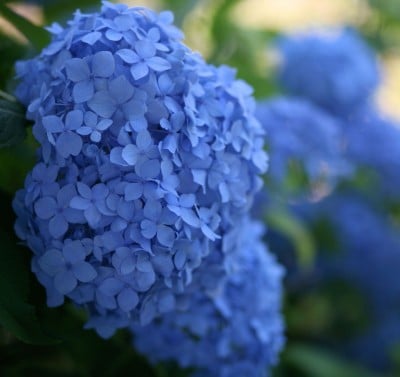
Now in the fullness of summer, my neighbourhood is burgeoning with bright pink hydrangeas, but not a blue one is to be found. They have handsome foliage and hortensia-style flowers, broad corymbs of large showy clusters, and also some of the lacecap forms with masses of tiny fertile flowers on the inside of the blossom and larger infertile flowers ringing the outer edges. These beautiful shrubs are bigleaf hydrangeas (Hydrangea macrophylla, Zone 7; Zone 6 with winter protection), and you may recognize them as the same plants sold in small pots in spring, around Easter time and then again at Mother’s Day. The potted hydrangeas are sold with white, pink or blue (ranging to purple and lavender) flowers and are grown in controlled greenhouse conditions. I’ve noticed that the blue-flowered plants always sell out first—everyone wants blue hydrangeas.
My grandmother had blue hydrangeas in her Zone 7 garden on the shores of the Atlantic Ocean (the shrubs are tolerant of salt air and mist), growing in acidic soil with a pH of about 5.5. The issue of pink versus blue hydrangea flowers is quite technical. Aluminum ions are what make blue flowers on bigleaf hydrangeas. Acidic soil has lots of free aluminum, but the alkaline soil in southern Ontario has very little.
While in the greenhouse, the small plants in pots are fed with regular doses of aluminum sulphate, which is thought to combine with an anthocyanin pigment, delphinidin-3-monoglucoside, to suppress pink and induce blue coloration. Bigleaf hydrangea will bloom with blue flowers in acid soil, white flowers in neutral soil and pink flowers in alkaline soil. This changeable flower colour is found only in H. macrophylla and its related species, mountain hydrangea (H. serrata, Zone 6). Other white-flowered hydrangeas, such as H. arborescens ‘Annabelle’ and H. paniculata ‘Grandiflora’, are unaffected by acid or alkaline soils.
Aluminum sulphate can be purchased at garden centres and fed to bigleaf hydrangeas, but it’s a risky business (an overdose can burn roots). The plants must receive it regularly (possibly twice a month), and the residual effects are eventually toxic to the plant. It’s more effective for containerized hydrangea shrubs, where the aluminum solution can be more effectively retained. In outdoor garden soil, the aluminum is leached away and flower colour may tend to a lavender-like mixture of blue and pink.
If you’ve purchased a small blue hydrangea in a pot for a holiday occasion and then planted it out into the garden, in subsequent years it has probably turned pink. Or, if you’ve purchased a bigleaf hydrangea shrub at a garden centre, such as ‘Nikko Blue’ (H. macrophylla ‘Nikko Blue’, Zone 5), it also may be producing pink flowers.
So, are blue hydrangeas a disappointing prospect? If you have patience and interest, perhaps it’s worth an experiment or two. Purchase a holiday pot of blue hydrangeas next spring, and put it into a larger and moveable container. Purchase the aluminum sulphate and read the dosage instructions very carefully. The blue hydrangea can be an accent plant, placed in a garden bed; or it can be a patio plant near where you sit outdoors. Keeping it in a container will prevent the aluminum sulphate from running off into the soil. Don’t prune, as flowers are carried by new growth on old wood. In autumn, take the plant into an unheated garage or cold basement room, put the container into a large plastic bag with the top folded over, but not sealed (to allow for air circulation). The soil should be just damp through winter, so check for water need every two weeks. Put it out into the garden next spring and begin treating it with aluminum sulphate again, and enjoy the blue flowers.
Now, one last idea. Some of the newly available Japanese mountain hydrangeas have potential for blue flowers. I’m going to try one of these shrubs next spring, possibly double purple H. serrata ‘Miyama Yae Murasaki’ (Zone 6), plant it into the garden, and give it the aluminum sulphate treatment. Although the flowers may not be purple, I might achieve a deep lavender—and that’s blue enough for me!
Surprise visit from cyclamen
Late summer garden cleaning has revealed a small treasure. Scattered about the feet of a Japanese maple, I found little groups of Cyclamen hederifolium, which have sent up their sweetly scented flowers in advance of the fancy marbled leaves to come later in autumn. I grew these from seed! They were easy to get started indoors, but not many of my seedlings were successful adapting to the garden. I guess these little guys found just the right spot. I’ll order more seed this autumn, and make them a winter project.

Hi Helen (August 18),
Yes, you might be lucky to have a hydrangea with (unaided) blue flowers; and you’re definitely lucky to have it remain fairly helathy in such a cold zone. Or could it be that there is a cultivar that has been bred to stay blue? Does your plant have a name? If you’ve got a name, please let us know. Wishing you lots more luck with that gorgeous plant. — Judith
Having read this article I would have to come to the conclusion that the beautiful little blue hydrangea in my back yard is doing so well by sheer luck!! I’m in a Zone 3.. maybe 4 in the very best circumstances i.e. in some “hot spots” in certain areas… I have done nothing special, just planted it last summer and hoped over hope that it would come back.. gave it a little extra mulch and bone meal but that’s it and surprise! Although the plant is on the small side the leaves and blooms are full size and gorgeous.. here’s hoping it will survive another winter 🙂